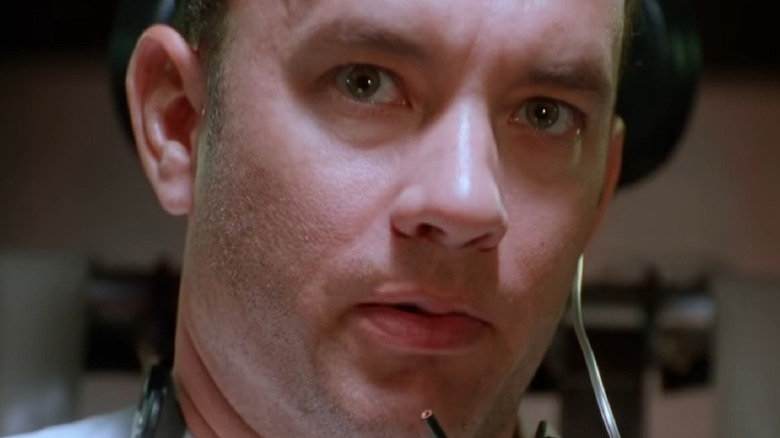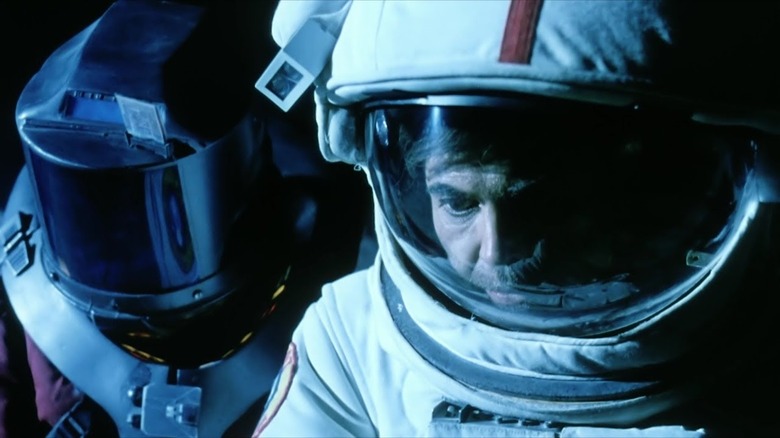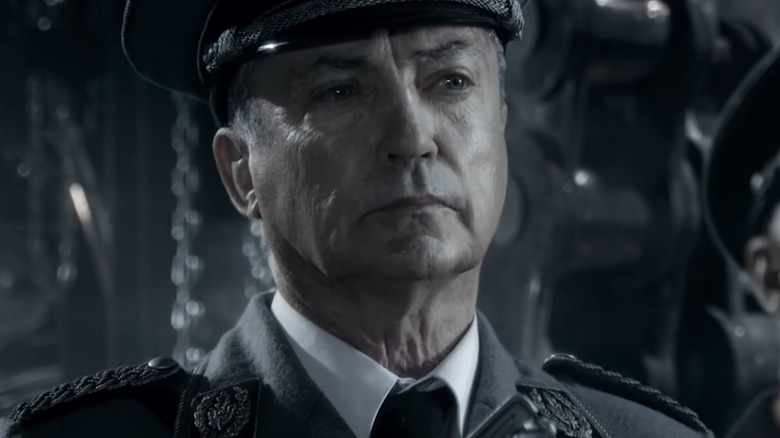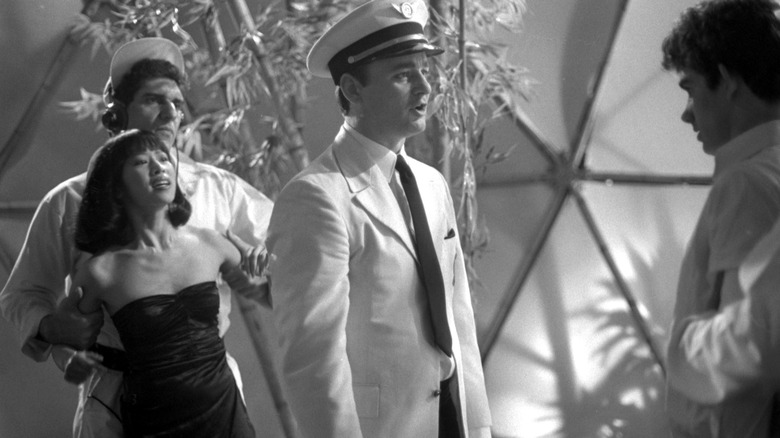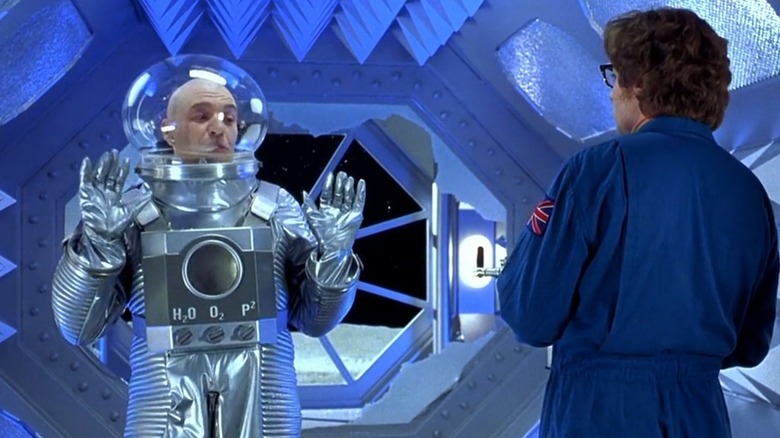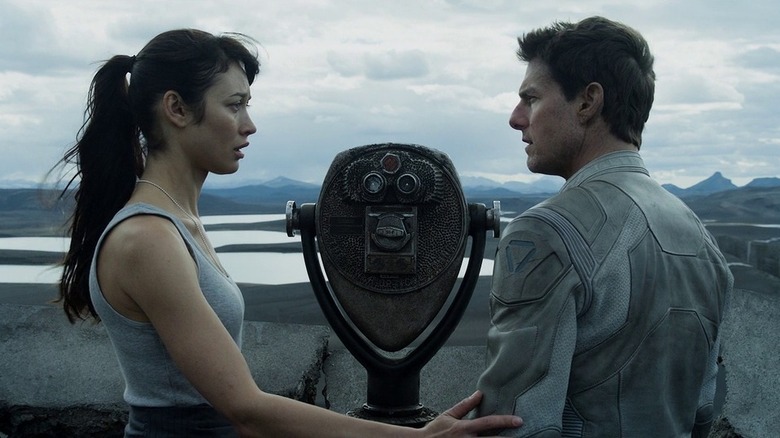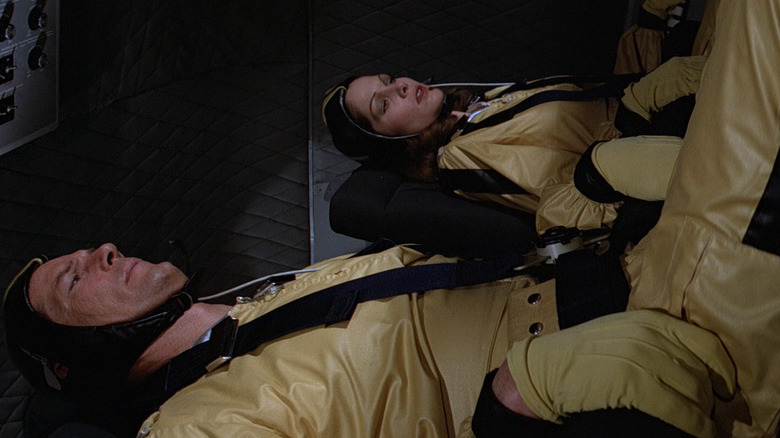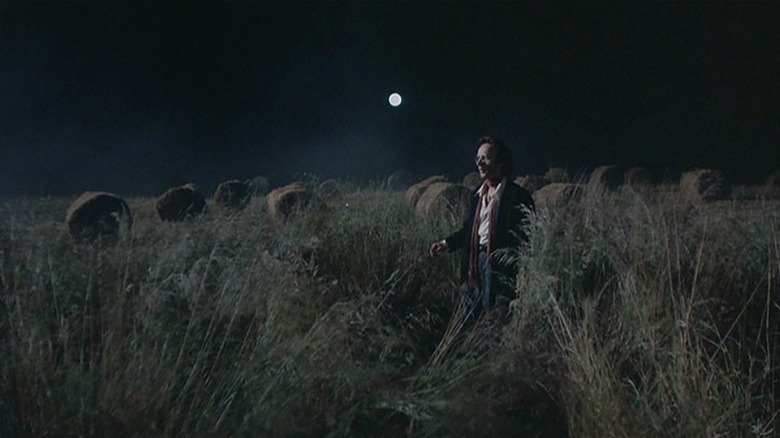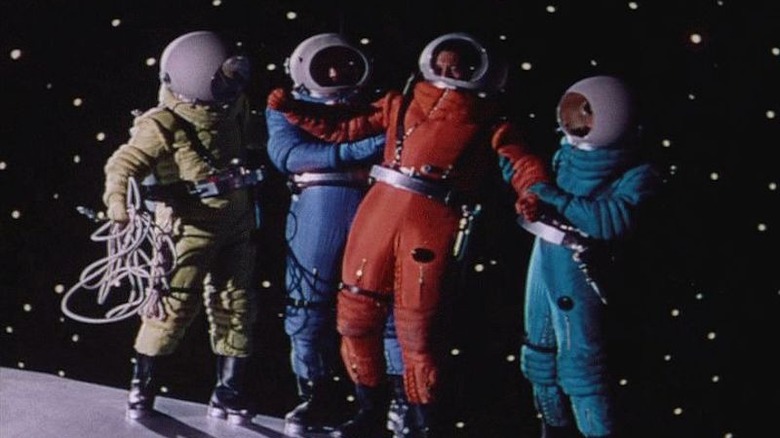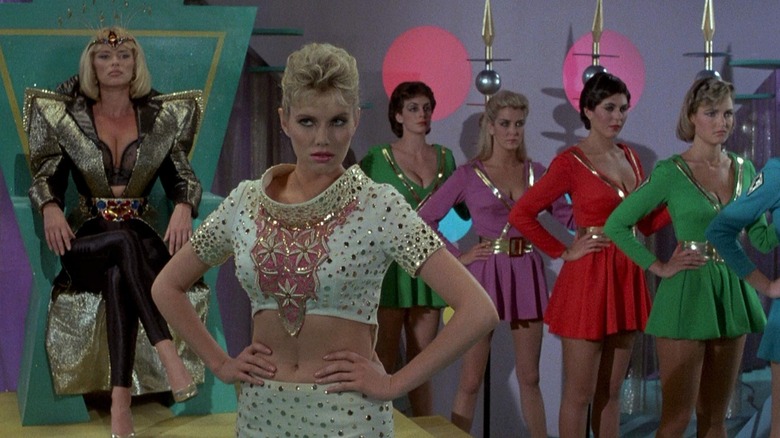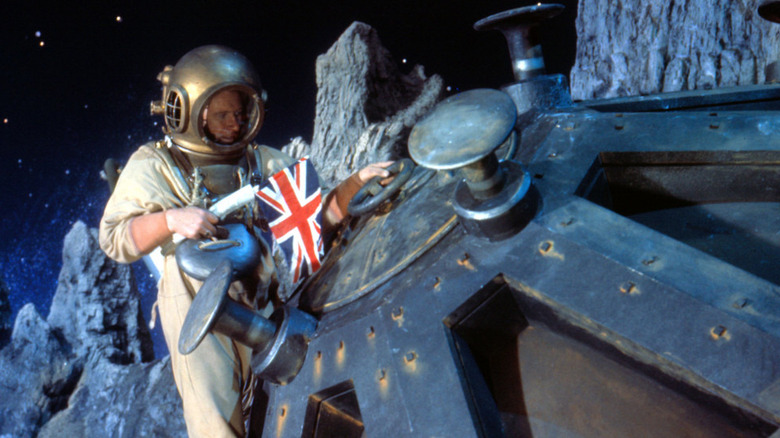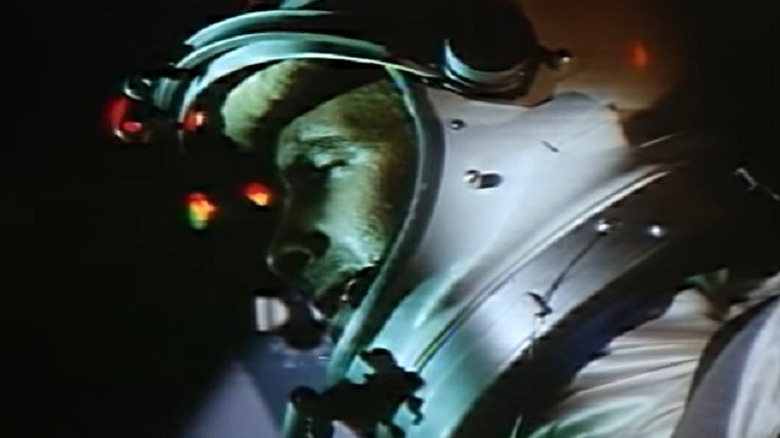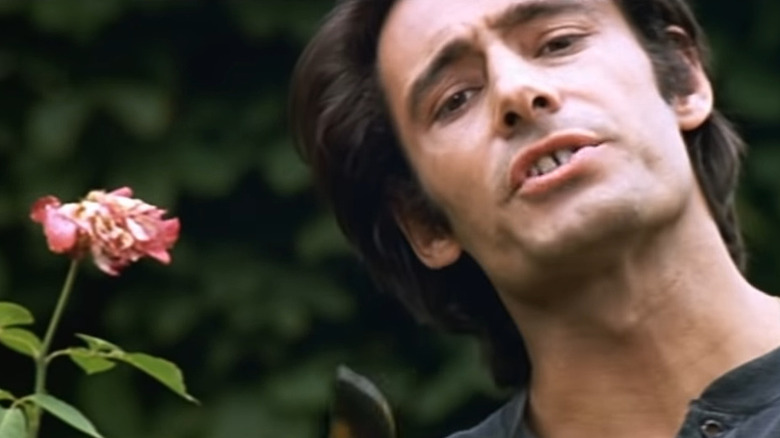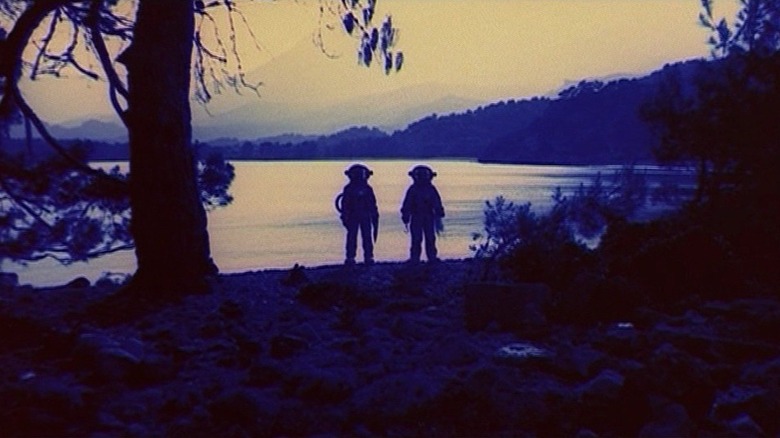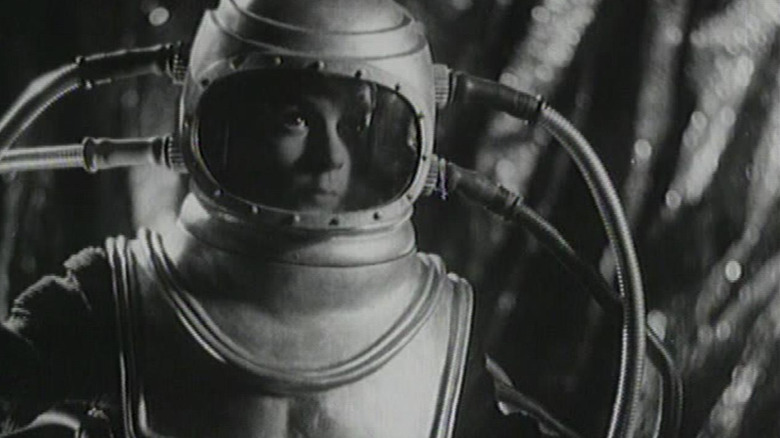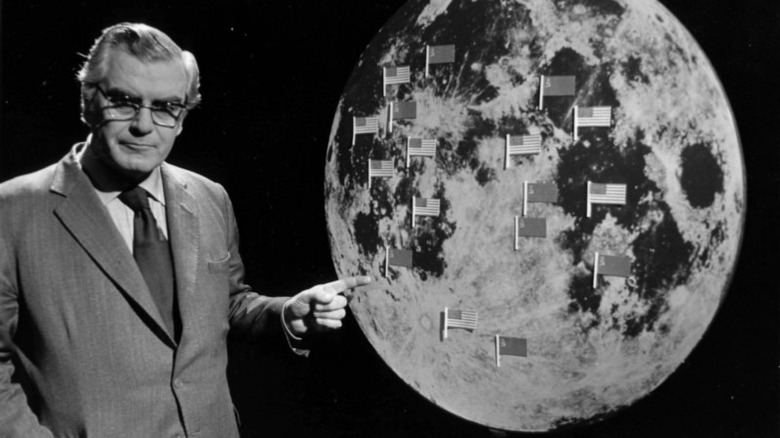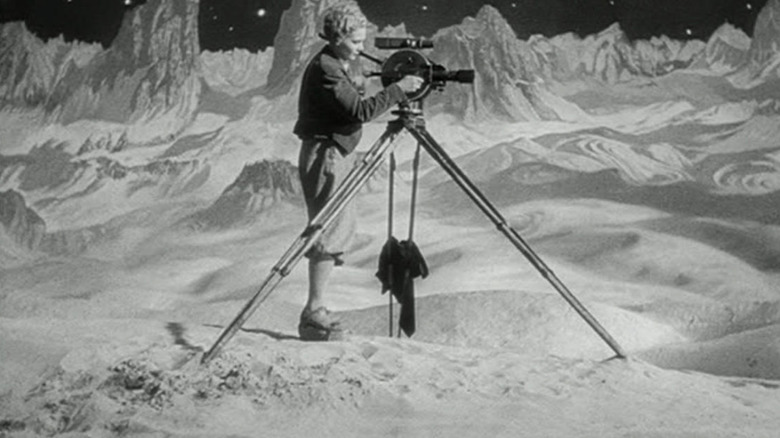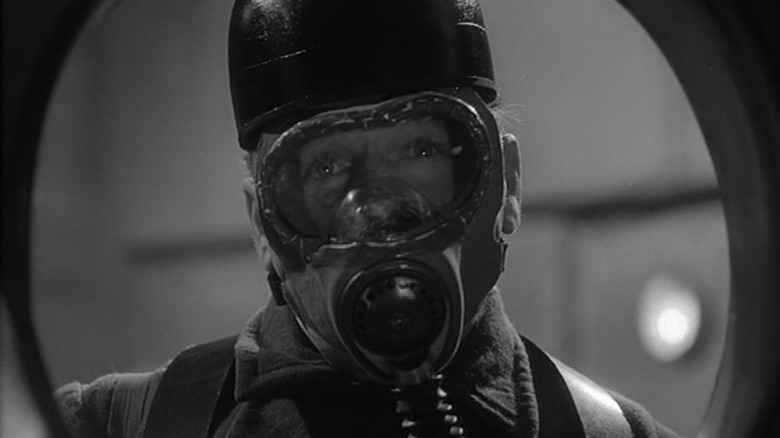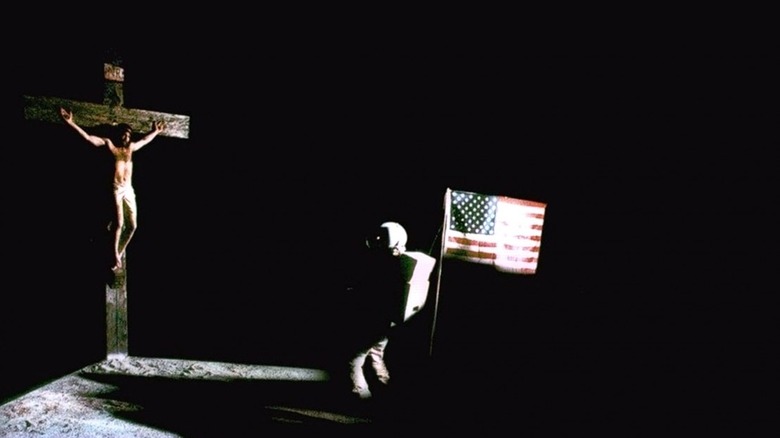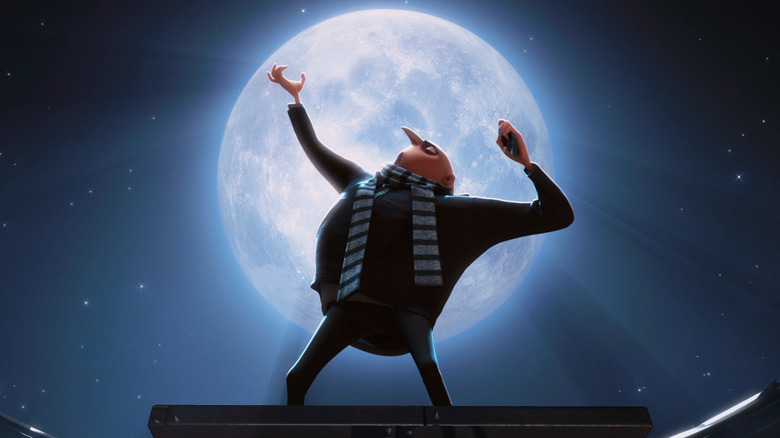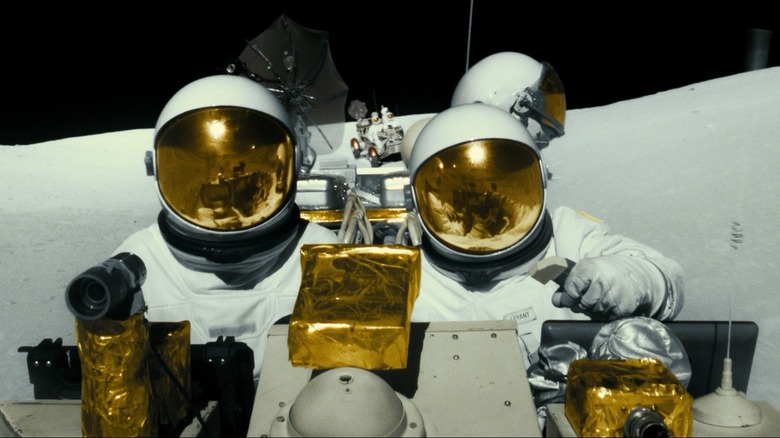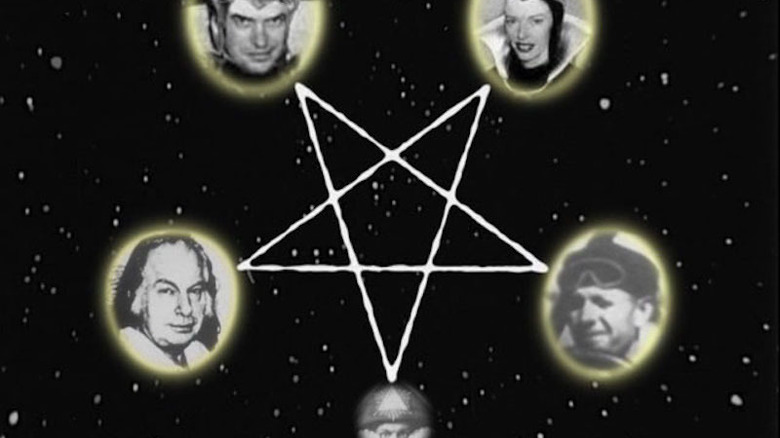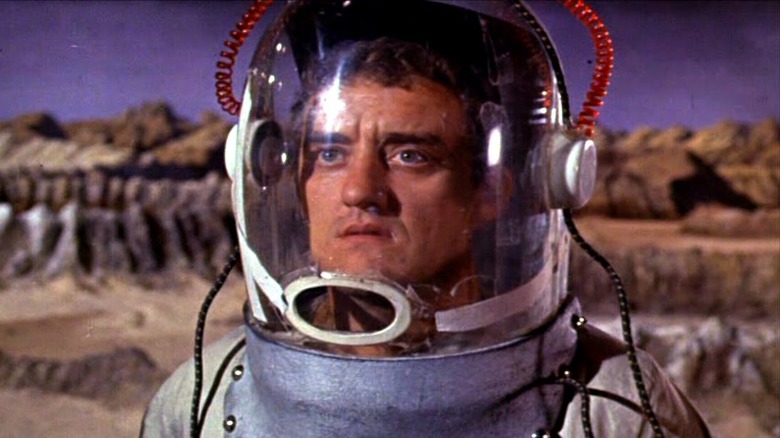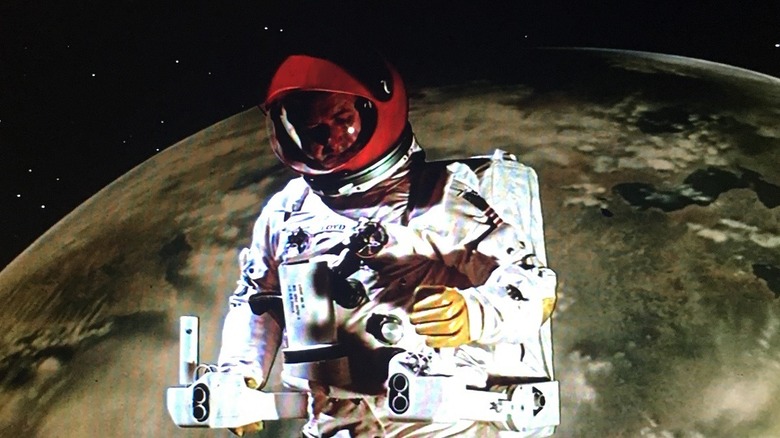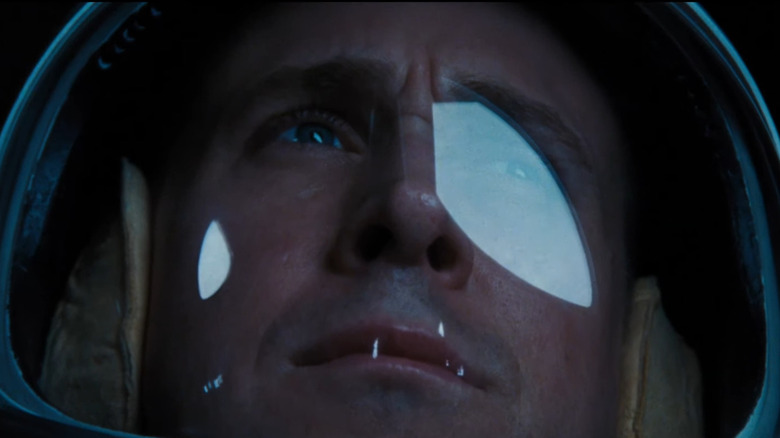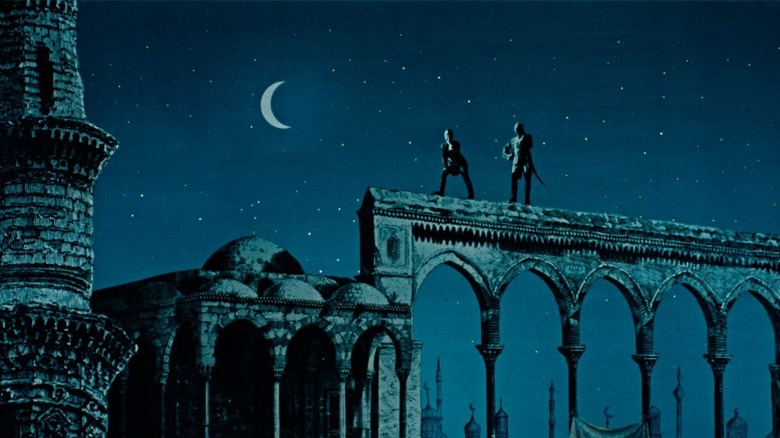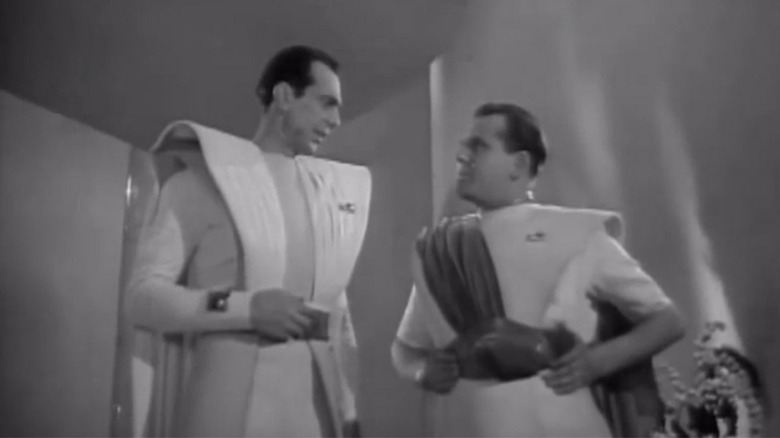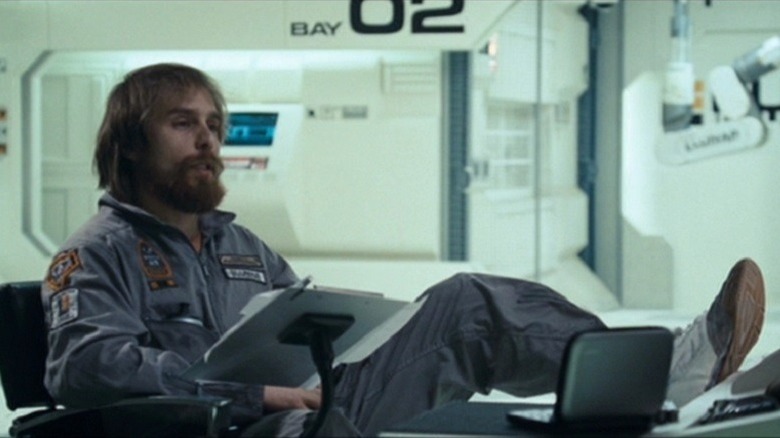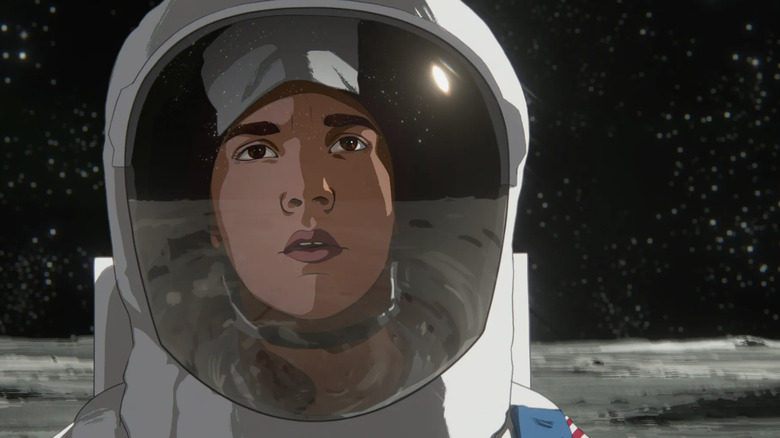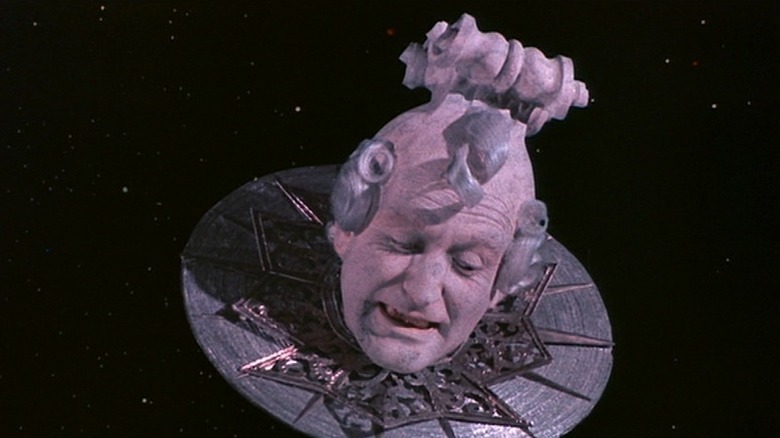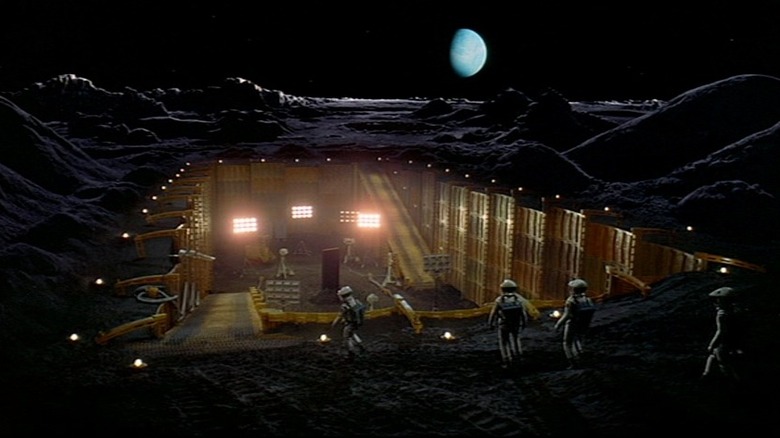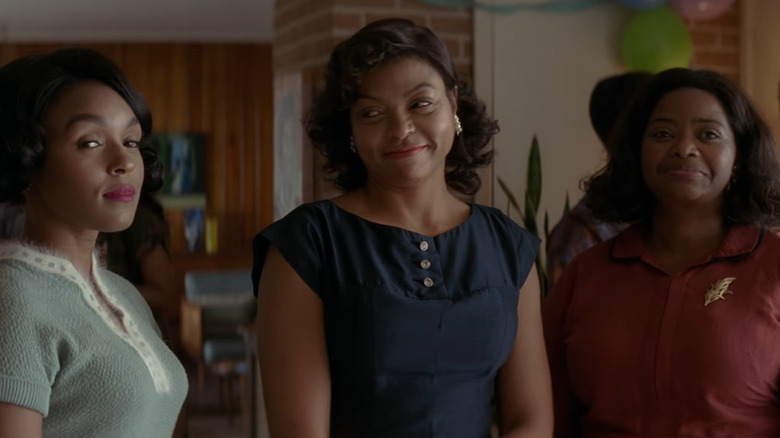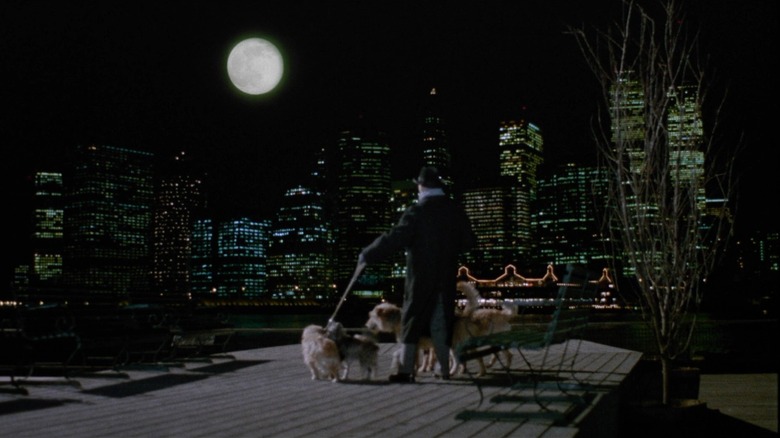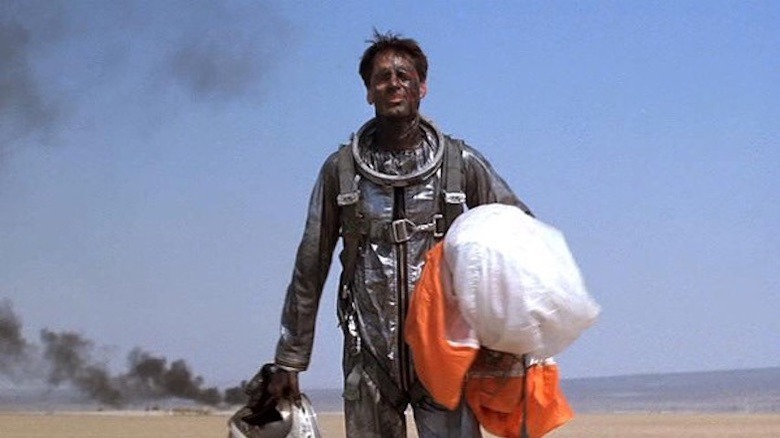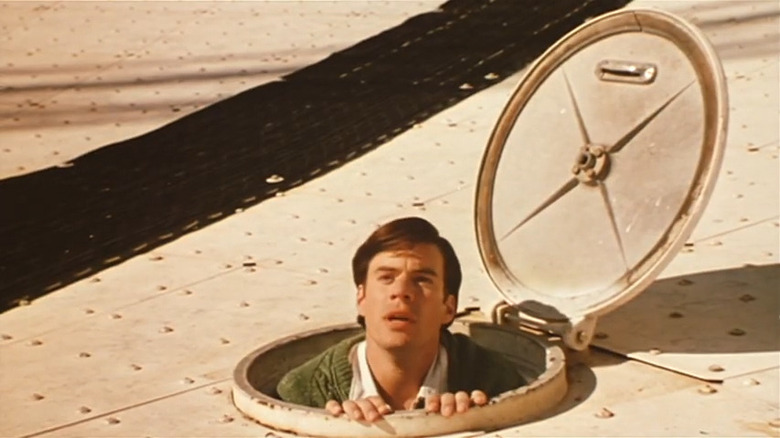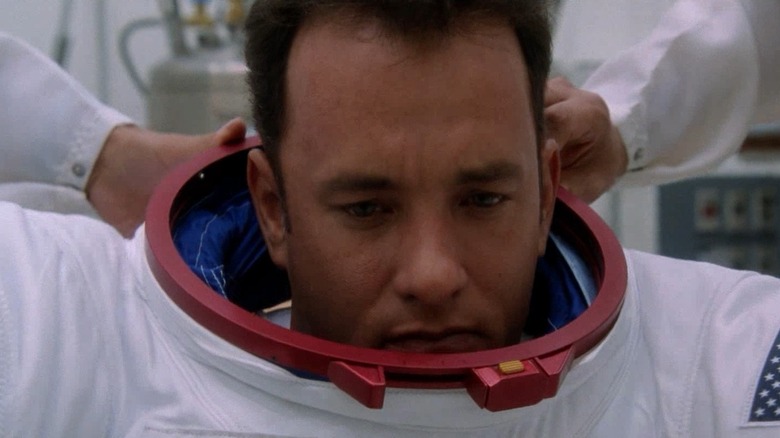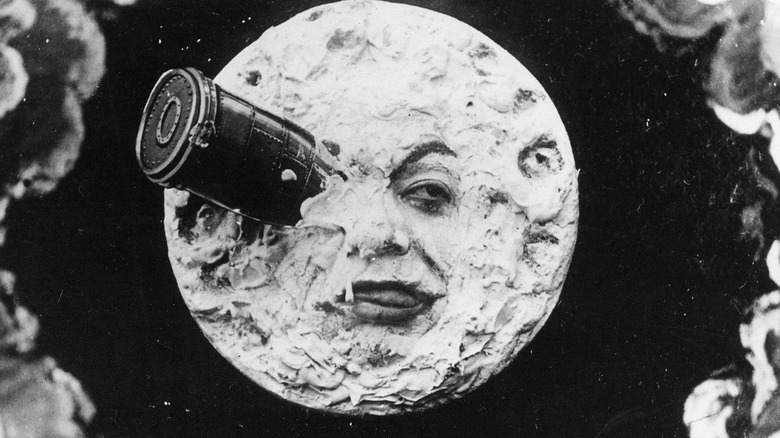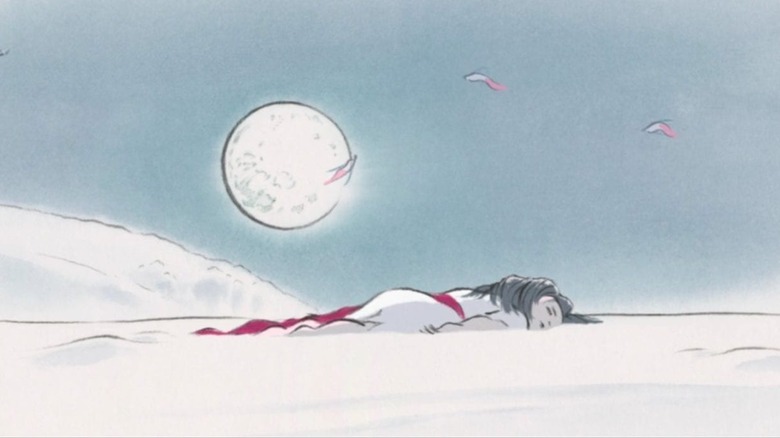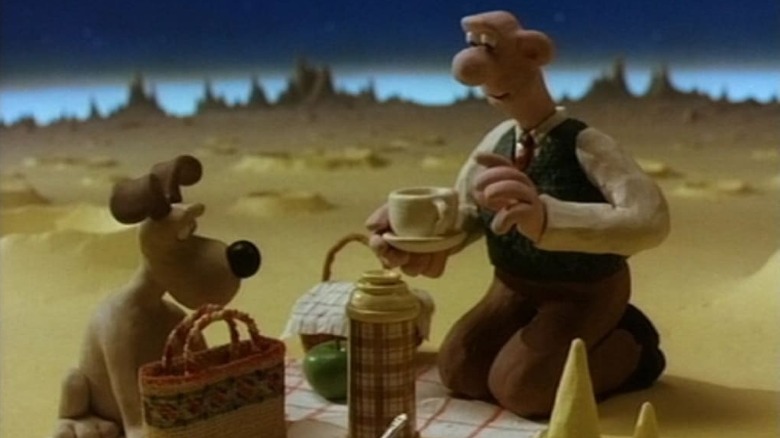38 Movies About The Moon For Every Space Lover
As one of the most visible celestial bodies visible from Earth with the naked eye, it's no surprise that the moon has had an immense influence over mankind's fascination with traveling beyond the stars. The moon appears in everything from folk legends to modern conspiracy theories. It's both a clear, material objective for enterprising astronauts and an out-of-this-world presence that governs everything from the tides to our love lives.
Naturally, ever since the invention of cinema, filmmakers have been finding captivating, terrifying, and inspiring ways to tell stories about the moon, from early cinematic special effects showcases that are now over 100 years old to modern-day blockbusters that dramatize the numerous enthralling stories of mankind's quest to take one small step on that dusty, porous, space rock. There are certainly no shortage of movies about the moon. Moon-vies, if you will.
But with so many movies about the moon, it can be difficult to know where to start. To boot, moon movies come in all shapes, sizes and genres, from experimental collages of found footage to outlandishly cheesy B-movies. Luckily for you, we've sorted through the vast array of films about the moon to bring you a rundown of the best of the best. So sit back, relax, and prepare for blast off with the following list of the best movies about the moon that cinema has to offer.
Moontrap
Yeah, yeah, yeah, "Moontrap" might not be the most prestigious or "well-reviewed" film on this list. But as you're soon to discover, dear reader, B-movies and the moon go together like peanut butter and jelly. There's something about Earth's beloved celestial rock that makes low-budget genre filmmakers' eyes light up. And while there are "better" moon B-movies out there, only one of them stars "The Evil Dead" star and famous chin-haver Bruce Campbell as a NASA scientist. That's worth the price of admission alone if you ask us.
The film follows a chilling discovery — a derelict spaceship etched with strange, archaic symbols containing a bizarre crimson pod and a shriveled corpse. Some scientific prodding reveals that the dead body is nearly ancient ... and originated from the moon. While our heroes zip into space to investigate before the Russians get wind of the news of an alien conspiracy ... the pod begins to stir.
Iron Sky
Some films about the Third Reich are deadly serious, stern, and sober. Others ask the question, what if there was a secret German space program that has been hiding out on the dark side of the moon since the end of World War II? You know, that old chestnut. The plan? Create a space base (in the shape of a hate symbol because subtlety has no place in this film) and a fleet of flying saucers to spearhead the Fourth Reich.
Incredibly silly without holding back any punches, "Iron Sky" is overacted cheesy nonsense that must be seen to be believed. Firmly planted in the satirical targets of 2012 (Sarah Palin send-up included), "Iron Sky" is outlandish dumb fun through and through. Take it on its own silly, satirical terms and enjoy one of the goofiest moon movies ever made, which, given some of the other films on this list, is really saying something!
Nothing Lasts Forever
When you think of "Saturday Night Live" films, what do you think of? "Wayne's World?" "The Blues Brothers?" What about the 1984 film from "SNL" writer-director Tom Schiller about a down-and-out artist falling in love with a woman who (literally) takes him to the moon?
Criminally underseen and under-loved, "Nothing Lasts Forever" tells of struggling artist Adam Beckett (Zach Galligan), who copes with bombing his piano test at Carnegie Hall by gallivanting off to Europe, only to return to find his home city of New York fundamentally changed and mildly dystopic. Beckett's adventures through the new-to-him city culminate in a trip to the moon facilitated by a rule-loving Bill Murray, where he'll meet his true love (Lauren Tom). A one-of-a-kind pastiche that plays like a long, heartfelt love letter to early 20th-century cinema, if you can get ahold of it, seek out this odd, incredibly charming gem.
Austin Powers: The Spy Who Shagged Me
The second entry in the excessively groovy "Austin Powers" trilogy, 1999's "Austin Powers: The Spy Who Shagged Me" sees our titular hero (Mike Myers) once again facing off against his arch nemesis, Dr. Evil (also played by Mike Myers). This go-round, the nefarious doctor's plan involves traveling back to the past to steal the most powerful, potent asset in British Intelligence: Austin Powers' mojo. With a swinging and exceptionally fashionable CIA agent named Felicity Shagwell (Heather Graham) in tow, Austin faces off against the forces of (Dr.) Evil, which include a supremely repugnant baby-eating Scotsman (also played by Mike Myers).
An unapologetic send-up of the James Bond franchise, the third act of the film is especially laser-focused on 1979's space-set "Moonraker." So, naturally, Dr. Evil has a moon base. Because what kind of James Bond villain knock-off doesn't want a moon base? Sure, it looks like it's made out of sheets of plastic and aluminum air duct tubes, but that's part of the charm, baby!
Oblivion
The year is 2077, the Earth is on its last legs, and Jack Harper (Tom Cruise) is one of the few remaining human beings on the planet — a drone technician tasked with keeping tabs on the planet and gathering resources before the final stragglers of the human race make their way to humanity's new home on Titan, one of Saturn's 82 moons. That's right, we snuck a non-Earth moon movie on this list. Then, one day, Jack stumbles across a pod containing a mysterious woman named Julia (Olga Kurylenko), whose face has recently been haunting his dreams for some unknown reason.
A veritable stew of science fiction tropes, "Oblivion" may be somewhat derivative, but sometimes movies don't have to be "good" to be enjoyable. Sometimes, it's enough to sit back, relax, and listen to the whir of futuristic spacecrafts. Take our advice: Go in with B-movie expectations (rather than Tom Cruise-helmed blockbuster expectations), and enjoy the round-edged, sci-fi shenanigans.
Moonraker
Roger Moore's fourth outing as international super spy James Bond sees agent 007 travelling around California, Venice, Rio, the Amazon, and outer space! The titular space shuttle, Moonraker, is missing. But surely the company's eugenics-loving, power-hungry owner (Michael Lonsdale) has absolutely nothing to do with it. With the metal-mouthed goon Jaws (Richard Kiel) nipping at his heels, Bond must locate the missing moon-themed space station to foil the plans of the megalomaniac du jour.
While all of the Moore Bond movies have their campy moments, "Moonraker" is the only outing to fully realize the goofy, ridiculous tone other films merely flirted with. If you're going to have a clownish Bond, why only do it halfway? And why not jump the shark and go to space? So yes, there is technically no moon in "Moonraker," but we're willing to bend the rules a little bit as far as this goofy, incredibly entertaining espionage romp is concerned.
The Voice of the Moon
The final feature film of iconic Italian filmmaker Federico Fellini (the genius behind the likes of "La Dolce Vita," "8 1/2," and "Nights of Cabiria"), "The Voice of the Moon" follows a recently dispatched mental patient, Ivo Salvini (Roberto Benigini), who experiences a cavalcade of adventures while attempting to woo the moon-faced love of his life. Maybe lassoing a large lunar rock will do the trick, who's to say? As is often the case with Fellini's films, "The Voice of the Moon" is dreamlike, with little hard-cut narrative to speak of. Instead, we drift from vignette to vignette, encountering an oddball cast and even odder scenarios (including, but certainly not limited, to a Michael Jackson-backed nightclub dance off).
The Italian master's swan song is a dizzying and subtly melancholic ode to the unpredictable highs, lows, and inexplicable ebb and flow of life. Even a "minor" Fellini film makes for a dreamy, atmosphere rich, and deeply personal watch. Playful and extravagant, "The Voice of the Moon" is not to be dismissed.
Destination Moon
Truth be told, most of the films on this list could have been called "Destination Moon." But don't hold its on the nose title against it. Released in 1950, nearly 20 years before we actually landed on the Moon for the first time, "Destination Moon" imagines what such a journey might look like. The film follows a rocket scientist (Warner Anderson) who wrangles up two friends to raise private funds to make their dream of a lunar landing a reality. Their journey encounters a slew of hiccups (including public nervousness about radiation). But the expedition reaches a pivotal point when the team realize that they have to leave one of their number behind on the moon in order to make it back to Earth.
A film with some pretty notable fans — Steven Spielberg and George Lucas, for example – "Destination Moon" is a film more concerned with the science than the fiction, using the majesty of technicolor to truly map out how a then-imaginary lunar landing might play out.
Amazon Women on the Moon
As its throwback title suggests, "Amazon Women on the Moon" is a satirical love letter to all the goofiness and low-budget charm of the kind of B-movies that make the rounds on late-night television. With multiple directors (Joe Dante, John Landis, Robert K. Weiss, Carl Gottlieb, and Peter Horton), the film mimics the experience of channel surfing at 2 AM, flipping from a man (Lou Jacobi) who winds up sucked into his TV to a hair-loss commercial where buyers are advised to staple carpets to their heads. In the background of all the chaos, the titular fictional 1950s B-movie blips in and out as an unseen viewer flips between channels during unexpected issues with the broadcast.
Whacky to its core, "Amazon Women on the Moon" is a genuinely heartfelt send-up to the subjects of its satirical gaze. Like all anthologies, some segments are stronger than others. But "Amazon Women on the Moon" is absolutely packed with skits. So before you know it, you're off to the next parody. All told, if you're amenable to offbeat humor, you can't go wrong with this 1987 smorgasbord of silliness.
The First Men in the Moon
Directed by B-movie heavyweight Nathan H. Juran (the man behind "The 7th Voyage of Sinbad" and "Attack of the 50 Foot Woman"), "First Men in the Moon" tells the story of three astronauts who land on the moon for the first time ... only to find a tattered British flag and a note claiming the moon for the glory of Queen Victoria. Locating the final surviving member of the 19th-century expedition, the team listens closely as the pioneering astronaut explains how he, a mad inventor, and his girlfriend made it to the moon in 1899.
Based on H.G. Wells' novel of the same name, "First Men in the Moon" features incredibly charming special effects from stop-motion master Ray Harryhausen. Part romantic comedy, part steampunk special effects showcase, "First Men in the Moon" is like a cheeseboard of moon-based B-movie tropes. A perfect Saturday morning matinee watch, taken on its own lighthearted terms, the film is a loopy lunar delight.
Countdown
Fueled with a burning desire to beat the Russians to the moon in the eleventh hour, NASA resolves to select an astronaut to launch at the celestial rock. The one hitch (and it's kind of a doozy)? The lucky candidate will have to twiddle their thumbs for almost a year until a sophisticated enough vessel can be sent to retrieve them. It's not so much a "cart before the horse" situation as it is a "launching a highly trained scientist at the moon before you've figured out how to bring him back" situation. What, you ask, could possibly go wrong?
Directed by the great Robert Altman, "Countdown" is an unabashed piece of pro-American, anti-Soviet propaganda that stands apart from much of the director's rebellious filmography. Even so, the lead performances smack of Altman's characteristic naturalism, which gives the narrative tension a distinctly late-1960s heartbeat. If you're willing to be flexible on the actual facts of the moon landing and are down to crack open the competitive jingoism of the Space Race, "Countdown" definitely deserves a spot on your watchlist.
There Were Days ... and Moons
Boasting what is far and away the weirdest title on this list, "There Were Days... and Moons" was directed by French filmmaker Claude Lelouch, perhaps best known for his 1966 romantic drama "A Man and a Woman." (For those of you wondering, no, the film's title doesn't make any more sense in French than it does in English).
Lyrical and miasmatic, "There Were Days... and Moons" follows a series of characters whose lives seem to be governed, influenced, or otherwise affected by the moon. And, look, if that big space rock can hold sway over Earth's tides, why shouldn't it have some impact on us? Aren't humans mostly water? In the grand tradition of many an "ensemble cast whose lives improbably intersect," the film charts how the full moon (bolstered by an especially auspicious overlap with daylight savings time) brings boons to some and bad luck to others.
Footprints on the Moon
Not to be confused with the 1969 documentary of the same name, Mario Fanelli and Luigi Bazzoni's 1975 Italian film (which also goes by "Le orme" and "Primal Impulse" just to complicate things further), follows a young translator named Alice (Florinda Bolkan) who has been experiencing an especially chilling recurring nightmare — a lone astronaut stranded on the moon. Guzzling sleeping pills to drown out the disturbing vision, Alice loses track of three days, also losing her job in the process. To say much more would give away the film's secrets. But suffice to say, if you were looking for a merger of a space thriller and the mystery-filled, black-gloved subgenre known as giallo, you don't need to look any further. (Also, wow, you have very specific interests!) Hauntingly abstract and certainly meriting the "fever dream" moniker, "Footprints on the Moon" is a gorgeously photographed, slow-simmering, and chilling watch.
Cosmic Journey
One of the earlier films on this list, "Cosmic Journey" lives up to its name. Released in 1936, Vasily Zhuravlyov's film pushes silent era special effects to their limits to imagine what a Soviet lunar landing might look like. The film follows three space-farers who launch themselves to the moon to prove that such a venture can, in fact, be done. Once there, the trio does what we would all do if we had the chance — namely, skip around like maniacs and enjoy the lighter gravity.
Despite its country of origin, the film boasts plenty of steampunk Jules Verne-like adventurism that is certainly worth a peek. We have plenty of films on this list, from all periods of history, that tell the story of the Space Race from an American perspective. Those interested in a different and strikingly prescient take would do well to seek this early Russian sci-fi film out.
Alternative 3
When you run out of alternatives one and two, what are you left with? Yes, we smuggled a TV movie on this list, but hear us out. Christopher Miles' 1977 film is a cut above your average DTV moon-fare. Framed as a "60 Minutes"-like investigation, the film looks into the mysterious disappearance of hundreds of U.K. scientists who've vanished without a trace. Depicting the first of a two-part exposé, the film digs up a variety of clues, whistleblowers, and chilling conspiracies. It's the end of the world as we know it, and somehow, the missing scientists, suspicious international space missions, and hushed whispers that something is up on the planet Mars — and a station on the moon — are all connected.
Perhaps only eclipsed by the BBC's 1992 TV movie "Ghostwatch" — which similarly blurred the muddy lines between fact, hoax, prank, and fiction — "Alternative 3" only grows more and more unnerving with each passing decade. To say much more would spoil the film's disturbing thesis. But if you have 52 minutes to spare, you should absolutely queue up this anxiety-riddled gem.
Women in the Moon
While plenty of modern-day filmgoers tend to think of older films as intimidating, dismissing all silent films outright would be a mistake. "Woman in the Moon" may be almost 100 years old, but don't hold its age against it! Directed by Fritz Lang (and released right before the German director's genre-defining masterpiece, "M"), "Woman in the Moon" kicks off with an inciting incident that (as far as we can tell) hasn't been used before or since — what if there was gold on the Moon? As if that bombshell weren't enough, "Woman in the Moon" boasts all manner of deliciously tense narrative wrinkles: greedy, bickering financiers, stowaway children, and chaotically unbridled scientific ambition.
While undoubtedly the less well-known of Lang's two sci-fi films (the other being "Metropolis"), "Woman in the Moon" is a visually stunning and gob-smacking early benchmark for the "more grounded" moon mission genre.
Quartermass 2
Not to be confused with 1955's "Quatermass II," 1957's "Quatermass 2" continues the adventures of Hammer Horror's preeminent gentleman scientist: Professor Bernard Quatermass (here played by Brian Donlevy). In this installment of the series, Quatermass has one out-of-this-world objective in mind — colonizing the Moon. While the bold, titular professor gazes starry-eyed towards the heavens, he bumps up against an intergalactic, body-snatching plot that aliens plan to invade our planet by dramatically changing our atmosphere. If only somebody had a bunch of nuclear rockets lying around...
Deftly directed by Val Guest (who also directed the series' previous entry, 1955's body horror sci-fi flic "The Quatermass Xperiment"), "Quatermass 2" is as dry as a well-made martini and full of enough goopy creature feature effects to satisfy the B-movie aficionado in your life. There are plenty of gruff, no-nonsense hero scientists on this list, and more than half of them owe their character tropes to one Bernard Quatermass!
The Ninth Configuration
William Peter Blatty, acclaimed author of the novel "The Exorcist," only directed two feature films. Luckily for moviegoers, they are both grade-A masterpieces. While the moon is missing from "The Exorcist III," its presence looms large over 1980's "The Ninth Configuration." Written, directed, and produced by Blatty — adapting his own 1978 novel of the same name — "The Ninth Configuration" tells of a massive castle in the Pacific Northwest that houses mentally disturbed U.S. soldiers and federal personnel. Among their number is Billy Cutshaw (Scott Wilson), a NASA astronaut who has totally lost his mind. Then, one day, the not altogether sane Colonel Kane (Stacy Keech Jr.) arrives to "rehabilitate" the patients through ... unorthodox means.
Unapologetically theological and paranoia-soaked, "The Ninth Configuration" is one of the most existentially alert films ever made. And with an ensemble cast of top-shelf character actors (including Jason Miller, Joe Spinell, and Tom Atkins), "The Ninth Configuration" is a powerhouse of cinematic philosophizing with an iconic lunar set piece sure to rattle you to your core.
Despicable Me
The film singularly responsible for introducing (cursing?) the world with Minions, Pierre Coffin and Chris Renaud's 2010 film follows the bald-headed super villain Gru (voiced by Steve Carell). When Gru starts to feel his star fading in the villainous shadow of his arch-rival Vector (voiced by Jason Segel), he resolves to pull off the most nefarious act imaginable — stealing the moon. But can the megalomaniacal maniac balance his celestial schemes with parenting three young girls?
While your mileage may vary depending on your capacity for extreme silliness, "Despicable Me" earns its spot on this list for its sheer audacity and cartoonish imagination. There are plenty of films about traveling respectfully to the moon. But there's only one film where a supervillain becomes a better dad by shrinking down and stealing the moon.
Ad Astra
Astronaut and daddy-issues-haver Roy McBride (Brad Pitt) is tasked with investigating the event that has haunted him his whole life — the disappearance of his father. A lifetime ago, Roy's dad Clifford (Tommy Lee Jones) vanished during an expedition to Neptune. Decades after his presumed death, strange destructive surges of energy threaten Earth. Their origin point? Neptune. Tasked with traveling across the galaxy to verify his father's demise, Roy hopes to finally find answers to the questions that have plagued him since he was a child. All he needs to do is travel 4.3 billion kilometers across the stars.
How does the moon figure into a mission to Neptune you ask? Well, before going deeper into space, you have to stop on the moon. In an incredibly memorable sequence vividly realized by director James Gray's artistic sensibility, Roy and company are ambushed by pirates. Moon pirates! Heck yes! Bringing color to a typically grayscale location with striking glimmers of gold, the moon sequence in "Ad Astra" absolutely guarantees it a spot on this list.
Mock Up on Mu
"Mock Up on Mu" is a difficult film to describe, as it's a movie that exists across both genres and time itself. Directed by experimental found-footage filmmaker Craig Baldwin, "Mock Up on Mu ” stitches together a collage of intertwined true-ish tales from post-war California, where visionaries and madmen alike looked to the stars for purpose and guidance. Pulling from everything from the inventor of solid rocket fuel to the infamous occultist Aleister Crowley, the New Age intertwines with the Space Age as Baldwin cobbles together archival footage into his own satirical narrative, which, among other things, proposes that L. Ron Hubbard lives in a rehab center on the moon. So, if you have a stomach for films made up of other films and find yourself vibing with Baldwin's idiosyncratic brand of filmmaking, "Mock Up on Mu" is certainly worth seeking out (though admittedly neither its contents nor its 2-hour runtime are for the faint of heart).
The Mouse on the Moon
The teeny, tiny, completely insignificant country of Grand Fenwick needs new plumbing. And what do you do when you need a fresh set of pipes? You request foreign aid from the United States and pretend you want to try your hand at intergalactic research. Things get complicated when the U.S. and the Soviets don't take too kindly to this new contender in the Space Race. Screw hot water, it's time to conquer the moon!
A pointed send-up of Cold War chicanery and the international posturing involved in laying claim to a hunk of space rock, "The Mouse on the Moon" is one of the few outright comedies on this list. Not only that, but it's a sequel to the equally hilarious "The Mouse that Roared," which sees the duchy of Grand Fenwick side-stepping bankruptcy by declaring war on the United States. Knowingly silly and charmingly directed by Richard Lester (of "A Hard Day's Night" fame), "The Mouse on the Moon" is a wildly pleasant watch and a welcome barrel of laughs among its more serious moon-movie peers.
Marooned
Now look, we can tell what you're all thinking, and you're right – it's a crime that this film wasn't called "Moon-rooned." Far be it from us to disagree with director John Sturges, the man behind the likes of "The Great Escape" and "The Magnificent Seven." But you can't call your film about being stranded in space "Marooned" and expect us to not to think about the moon. After all, the 1969 film hit theaters only a couple of months after the historic Apollo 11 moon landing. The moon was on everyone's mind!
In all seriousness, "Marooned" lives up to its name, following the story of three astronauts (Richard Crenna, James Franciscus, and Gene Hackman) who find themselves stranded in space. With only enough oxygen for two days, the question becomes whether or not NASA should risk sending up a rescue team. Incredibly methodical and full to the brim with technical jargon (though luckily for us, it's Gregory Peck delivering most of said jargon), "Marooned" is a suspenseful watch and easily one of the best films to ever appear on "Mystery Science Theater 3000."
First Man
If there's one name that goes hand in hand with the moon, it's Neil Armstrong, the first person to walk upon that craggy lunar landscape. Directed by Damien Chazelle (who readers may know for 2014's "Whiplash" and 2016's "La La Land"), "First Man" dramatizes Armstrong's journey from humble civilian test pilot to one of the most inspiring and enigmatic astronauts mankind has ever produced. With a striking lead performance from Ryan Gosling as Armstrong, "First Man" takes aim thematically at the machismo and nationalistic posturing of the Space Race while producing a touching, intimate, and humanizing portrait at the same time. While dabbling in its fair share of biopic clichés, the film absolutely nails the claustrophobia, death drive, and tension of being shot into space. It's a film well worth the watch for the lunar module sequences alone. The stunning cinematography from Linus Sandgren and the technical prowess of the film's special effects are just the icing on the cake.
The Fabulous Baron Munchausen
Terry Gilliam's 1988 film might be the most well known cinematic outing of the infamous Baron Munchausen. But it's not the only big screen outing of the illustrious fictional aristocrat. Released in 1962, the Czechoslovakian adventure film blends a variety of animation styles and live action to bring the Baron's absurd, ridiculous, and fantastical adventures to life.
When the film begins, a cosmonaut named Toník (Rudolf Jelínek) arrives on the moon only to discover that he is not the first man to accomplish a lunar landing. In the presence of the great Baron, the astronaut is whisked away back to an Earth that is exaggerated, magical, and full of sea battles, damsels in distress, and airships pulled by winged horses. How many movies concerned with the moon also star the fictional big-nosed romantic Cyrano de Bergerac? Thoroughly unique and powerful proof that cinematic special effects don't need to emulate reality to be captivating, "The Fabulous Baron Munchausen" is a marvelous film we love dearly to the moon and back.
Things to Come
An oldie (but a goodie), 1936's "Things to Come" marks a noteworthy collaboration between the legendary writer H.G. Wells and director William Cameron Menzies. Leaping and bounding forward through time, "Things to Come" speculates on what the coming century has in store for humanity ... which includes (say it with us) man's inaugural flight to the moon. An epic in the true sense of the word, loosely adapted from Wells' own novel "The Shape of Things to Come," the film eschews gilded optimism for a far more measured, darkly tinged glimpse into the future.
A landmark of sci-fi cinema that predates much of the aesthetic and tenor of the genre boom of the 1950s, Wells' take on futurism boasts an immense scope and somehow, despite the odds, manages to tease out a sliver of tempered optimism out of our self-destructive tendencies. We've said it a couple of times on this list already, but we'll say it again — don't let this film's age scare you off! The themes of "Things to Come" are, for better or for worse, truly timeless.
Moon
Lonely astronaut Sam Bell (Sam Rockwell) is a contract worker on the moon, tasked with harvesting helium-3 from lunar soil. In this not too distant future, helium-3 is an essential energy source that has provided an elegant solution to the climate crisis threatening the Earth's survival. Living alone on the dark side of the moon, with only a chirpy artificial intelligence (voiced by Kevin Spacey) for company, all of Bell's basic needs are met. But as anyone who rode out the early days of the COVID-19 pandemic alone will tell you, a job and hobbies are not exactly a worthy substitute for human contact. We won't spoil the crucial twist of "Moon," but suffice to say, the circumstances of Bell's loneliness get way, way more complicated. Intelligently directed by Duncan Jones, "Moon" features a demanding powerhouse performance from Rockwell that asks some difficult questions about our tenuous modern relationship to labor.
Apollo 10 1/2: A Space Age Childhood
Richard Linklater is no stranger to rotoscoping, the animation process in which either hand-drawn or digital images are "laid over" live-action performances. Fans of the Texan director have seen Linklater employ the process in both 2001's "Waking Life" and 2006's "A Scanner Darkly." But where those efforts used the uncanny qualities of rotoscoping to invoke dreams and drugs, respectively, "Apollo 10 1/2: A Space Age Childhood" uses the technique to give Linklater's suburban tale a nostalgic, fantastical warmth.
As is the case with much of Linklater's work, "Apollo 10 1/2: A Space Age Childhood" is light on plot points but rich in vibes and characterization. The film relays the iconic 1969 moon landing from the perspective of the NASA operation and eyes of a starry-eyed Texas kid (voiced by Milo Coy and Jack Black at different ages), one who daydreams that he secretly paved the way for Neil Armstrong's iconic moonwalk. Full of incredibly charming animation, "Apollo 10 1/2: A Space Age Childhood" is sure to make you nostalgic (even if you didn't grow up in Texas during the 1960s).
The Adventures of Baron Munchausen
In an age dominated by adequacy, the fantastic eccentricities of Baron Münchhausen captivate the public. Then, during a play depicting the events of the Baron's life, a man (John Neville) claiming to be the Baron corrects the inaccuracies of the production by launching into an oral history of his real exploits. Then, in the midst of narrative tales of grandeur, the city falls under siege, giving the Baron yet another chance to show off his bombastic talents. Then again, maybe this is all just another tale being told from some other Baron. This is a film directed by Terry Gilliam of "Monty Python" fame, after all.
What does all of this have to do with the moon, you ask? How dare you underestimate the abilities of the Baron! Who else but Herr Münchhausen could travel to the moon in a hot air balloon made out of women's underwear? Oh, and did we mention that the king of the moon is played by Robin Williams? Because he is! If all of this is ticking boxes for you, seek out this delightfully absurd romp around 18th-century Europe and beyond the stars.
2001: A Space Odyssey
Stanley Kubrick's sci-fi masterpiece takes place in a variety of locations across the galaxy. We begin in prehistoric Earth and go as far as Jupiter (slipping through dimensions along the way, but that's neither here nor there). After its ape-filled opening segment, the film sees humanity discovering a mysterious object buried on the moon — a pitch-black monolith that's sending bizarre, inscrutable signals to Jupiter.
The operatic, non-verbal opening segment and the third act with its rogue AI and existential nightmare fuel often overshadow the more languid middle section, which follows Dr. Heywood Floyd (William Sylvester) as he travels to the moon. It's a protracted and methodical portrayal of what commercial lunar travel might look like, exacting in its detail and in no hurry to brush over any of the mechanics of how such a voyage might play out. Simultaneously plausible and speculative, the middle segment of "2001: A Space Odyssey" may require a bit of patience. But for our money, it's all worth it for the final, haunting reveal of the dark structure hidden deep beneath the lunar crust.
Hidden Figures
Released in 2016, "Hidden Figures" dramatizes the real and under-told story of Katherine G. Johnson (Taraji P. Henson), Dorothy Vaughn (Octavia Spencer), and Mary Jackson (Janelle Monáe) — three Black women who worked for NASA during the height of the Space Race. Contending with discrimination both because of their gender and the color of their skin, the odds are stacked high against the trio. Who'd have thought the hard part of pioneering the math that put humanity on the moon would be office politics and ridiculous segregation laws?
While "Hidden Figures" is absolutely a textbook progressive historical biopic, it's also incredibly satisfying ("feel-good," as the saying goes) to watch these three incredible women succeed and outsmart a system primed to see them fail. Resilience is what got humanity to the Moon, and "Hidden Figures" positions that resilience front and center. Yeah, it's cheesy. But you know what's also made of cheese? The moon. Checkmate.
Moonstruck
An unimpeachable romantic comedy and one of the greatest holiday movies not explicitly about Christmas, Norman Jewison's 1987 masterpiece is also one of the greatest movies out there about the moon. While neither Cher or Nicolas Cage don a space suit or hop about on the craggy surface of the moon, the celestial rock has such a powerful presence over this film that we feel totally confident including it on this list.
"Moonstruck" follows Loretta Castorini (Cher), a Brooklynite widow who accidentally falls for the bombastic younger brother (Cage) of her wimpy fiancé (Danny Aiello). Over the course of the film, the moon looms large. Quite literally. Its enormous nocturnal glow illuminates many a nighttime tryst and solitary dogwalk — it's impossibly radiant and large, like one of the set pieces in an operatic production at the MET. A repeated refrain is that, much like the tides, the moon's gravitational pull brings lovers together, old and new. Boundlessly romantic and radiant, "Moonstruck" is one of the greatest films about the more emotional power the moon holds over our lives.
The Right Stuff
You can't throw a space rock at movies about the moon without hitting a "based on a true story" film. Enter 1983's "The Right Stuff," which charts the first 15 years of America's space program.
With a focus on the space farers associated with the Mercury Seven, one of NASA's earliest achievements, the film is adapted from Tom Wolfe's 1979 non-fiction novel of the same name. Philip Kaufman's film highlights all the thunderous bravado, guts, and personal sacrifice that paved the way for NASA's future accomplishments. Balancing a character study with grand historical myth making, "The Right Stuff" is a distinctly American-made, technically well-crafted, and unequivocally epic tale of the adrenaline junky cowboys who made Project Mercury, the U.S.' first human spaceflight program, a reality.
Featuring one of the all-time best cast ensembles of all time (including Sam Shepard, Scott Glenn, Ed Harris, and Dennis Quaid), you might say that this film has ... the right stuff. (Sorry, we couldn't help ourselves).
The Dish
Released in the year 2000 and directed by Australian filmmaker Rob Sitch, "The Dish" takes place in Parkes, a remote community in the Land Down Under that houses a massive satellite dish in the middle of a sheep farm. The titular dish has a very important job — to broadcast Neil Armstrong's moonwalk to the rest of humanity. The events leading up to the broadcast are told from the perspective of Cliff Buxton (Sam Neill), who was the man in charge when NASA arrived on the scene to take charge of the satellite to transmit footage of the first Apollo moon mission.
A true story that leans on one of the more heartwarming notes in the Space Race story, "The Dish" is one of the rare films on this list to depict the moon landing from a non-American perspective. A mellow, low-key, and charming tale about how a small Australian town contributed to one of humanity's greatest accomplishments, the best quality about "The Dish" is its ability to carve a distinctly Aussie identity onto a historical event that is often recounted with American bravado.
Apollo 13
An action-packed dramatization of the ill-fated Apollo 13 mission, Ron Howard's 1995 film unpacks the incredible fortitude of the crew and Mission Control staff in the wake of an oxygen tank explosion that cripples the titular spaceship. Mankind's third moon landing is canceled. The itinerary now reads: Don't suffocate, blow up, or get sucked out into the vacuum of space. Capturing the intense pressure and resolve that goes hand-in-hand with space travel, "Apollo 13" is a masterclass in expository dialogue and one of the greatest films about the narrative satisfaction of seeing competent people solve problems.
An engaging and professionally realized piece of filmmaking that boasts a suspense-filled script and an impeccable ensemble cast (including Tom Hanks, Bill Paxton, Kevin Bacon, Gary Sinise, and Ed Harris), "Apollo 13" is a certified crowd-pleaser that teases heroics out of potential tragedy.
A Trip to the Moon
Easily the oldest, and shortest, film on this list (clocking in at a snappy 15 minutes), Georges Méliès' 1902 sci-fi effort features arguably one of the most iconic images in all of cinema history — a rocket lodged in the eye of the man in the moon. If you find early cinema intimidating or off-putting in any way, trust us when we say that you can't go wrong with "A Trip to the Moon," which is as brisk as it is imaginative, brimming with nascent special effects and an infectious scientific curiosity. The film's plot follows, get this, a trip to the moon — from the project's planning stages to the construction of the rocket to the exploration of the lunar surface's many hidden secrets.
It's difficult to speak to films that are so intrinsic and baked-in to film history without dovetailing into hyperbole. But the charms of "A Trip to the Moon" are not to be denied. This is a film that commands respect for a reason, with "dated" effects sublimating into timelessness thanks to Méliès' undeniable talent for stylization. An incredible experiment in and of itself, "A Trip to the Moon" is an unmissable piece of cinema history that is well worth seeking out.
The Tale of Princess Kaguya
The final feature film directed by iconic Japanese co-founder of Studio Ghibli, Isao Takahata, "The Tale of Princess Kaguya" is based on a 10th-century Japanese monogatari, "The Tale of the Bamboo Cutter," one of the country's oldest surviving fables. Mirroring its source material, Takahata's 2013 film tells of a humble farming couple who discover a tiny princess growing out of a bamboo stalk, who they adopt as their own daughter. When the bamboo provides a small fortune of gold coins, the couple take their good fortune as a sign to move their small family to the city to raise their daughter as a member of high society. A tomboy at heart and more at home in the woods than the court, the princess resists her family's efforts to find her a husband.
To describe the specifics of how, exactly, the moon figures into all of this would give away much of the film's third act secrets. And while you might think being cagey about spoilers for a centuries-old tale is weird, the reality is that many Western viewers are unfamiliar with the story's specifics. So please, go watch this masterpiece for yourself. You won't regret it, we promise.
A Grand Day Out
Over the course of this list, we've seen a handful of different ways filmmakers approach the moon as a cinematic subject. For some films, the moon is a means to a political end or a benchmark of human potential. In others, the moon is a stage for fantasy and speculative science fiction — a terrifying alien prison or the first step towards mankind's greater quest beyond our solar system.
But the best film about the moon has far more humbler ambitions. The titular Wallace and Gromit — a ditsy British inventor (voiced by Peter Sallis) and his intrepid canine companion — have run out of cheese. With their home cleaned out of the delicious dairy product and indecisive about what they should do for a weekend getaway, the two set their sights to the stars because, as everyone and their dog knows, the moon is made of cheese. Only, when the duo arrive for their lunar picnic, they find they're not entirely alone.
Arguably the grandest day out of all time, the 1989 film is overwhelmingly lovely, filled with adorable details and a tactile, lived-in look that give the entire affair an undeniable charm. Space is a terrifying, exhilarating, and boundless place, but in the claymation hands of Wallace and Gromit, the moon and its surrounding void feel warm and inviting.
